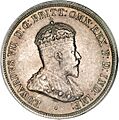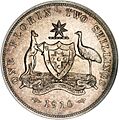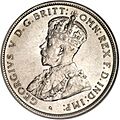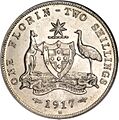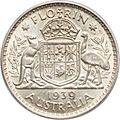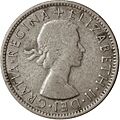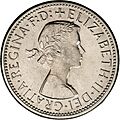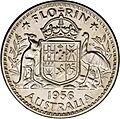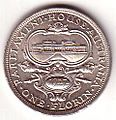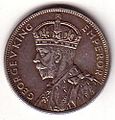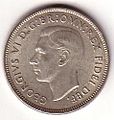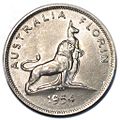Florin (Australian coin) facts for kids
The Australian florin was a special coin used in Australia a long time ago, before 1966. It was worth two shillings, which was like 24 old pence. Think of it as one-tenth of an Australian pound.
The first florins were made in 1910. They were the same size and weight as the British florin.

From 1910 to 1945, florins were made with lots of sterling silver (92.5% silver). They weighed about 11.31 grams. This means they had a good amount of real silver in them.
After 1945, from 1946 to 1963, florins were made with less silver (50% silver). They still weighed 11.31 grams. The coin was made until 1963, but not every year. For example, no florins were made in 1920, 1929–30, 1937, 1948–50, and 1955.
Special florins were also made to remember important events. These were called "commemorative" florins. They were issued in 1927, 1934–35, 1951, and 1954. In these years, two different designs were made: the regular one and a special memorial design.
No Australian coins of any type were made in 1965. This was because Australia was getting ready to change to a new money system called decimalisation. This happened on February 14, 1966. When Australia switched to decimal money, one florin became equal to 20 cents.
During World War II, from 1942 to 1944, more florins were needed. So, some were made in the United States at the San Francisco Mint. These coins have a small "S" mint mark on them. This "S" is found below the Australian coat of arms.
Contents
Designs on the Coin
The side of the coin that usually shows the country's symbol is called the reverse. On most florins, this side showed the coat of arms of Australia. This coat of arms always features a kangaroo, an emu, and a shield.
There were two main types of coat of arms designs:
- 1910 to 1936: These coins had a seven-pointed star above the coat of arms. The shield on these coins showed the Southern Cross constellation.
- 1938 to 1963: These coins had the royal crown above the coat of arms. The shield showed symbols for the six states of Australia. There was also a golden wattle plant in the background.
Different Types of Florins
Over the years, different kings and queens appeared on the "obverse" side of the florin (the side with the ruler's head).
- 1910: The first florins showed Edward VII.
- 1911 to 1936: These coins featured King George V.
- 1938 to 1945: Florins from these years showed George VI. These coins were made with 92.5% silver.
- 1946 to 1952: Florins from these years also showed King George VI. However, these coins were made with less silver (50% silver).
- 1953 to 1963: The later florins featured Elizabeth II.
All florins had a reeded edge, which means they had small grooves around the rim.
Special Commemorative Florins
Some florins were made to celebrate important events in Australia's history. These coins had unique designs on their reverse side.
- 1927: This florin celebrated the opening of the original Parliament House in Canberra.
- 1934–35: This florin marked 100 years since the city of Melbourne was founded.
- 1951: This coin celebrated 50 years since the Federation of Australia, when the different colonies joined together to form one country.
- 1954: This florin was made to remember the first time a reigning monarch (Queen Elizabeth II) visited Australia.
Where Coins Were Made: Mintmarks
Sometimes, a small letter or symbol called a "mintmark" was put on a coin. This mark tells you where the coin was made.
- H: This means the coin was made in Birmingham, England.
- M: This means the coin was made in Melbourne, Australia.
- S: This means the coin was made in San Francisco, United States.
Images for kids
-
Reverse of the 1927 Australian florin commemorating the opening of the original Parliament House.
-
Obverse of the commemorative 1927 Australian florin, with
King George V. -
Obverse of the 1954 Australian florin, with Queen Elizabeth II.


